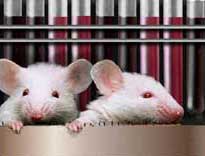Natural evolution has produced the eye, butterfly wings and other wonders that would put any inventor to shame. But who's to say evolution couldn't be improved with the help of a little technology?
Augmenting the Animal Kingdom
By Lakshmi Sandhana
So argues James Auger in his controversial and sometimes unsettling book, Augmented Animals. A designer and former research associate with MIT Media Lab Europe, Auger envisions animals, birds, reptiles and even fish becoming appreciative techno-geeks, using specially engineered gadgets to help them overcome their evolutionary shortcomings, promote their chances of survival or just simply lead easier and more comfortable lives.
On tap for the future: Rodents zooming around with night-vision survival goggles, squirrels hoarding nuts using GPS locators and fish armed with metal detectors to avoid the angler's hook.
Auger's current ambitions are relatively modest. He's developing a LED light that aims to translate tail wagging into plain English. The device fits on a dog's tail, and flashes text messages when the tail waves through the air. He plans to have a working product on display at Harrods in London by September.
"I'm serious about the ideas behind the products," says Auger. "I think that the fact that some of them could be realized means that as concepts they tread the scary line between fact and fiction and therefore are taken a little more seriously. If one person in a hundred is inspired to think about the philosophical issues behind the ideas and the other 99 read it like Calvin and Hobbs, I'd consider that a success."
Auger admits that his ideas are mostly conceptual in regard to animals living in the wild. But for tame and domesticated companions, some may not be so far-fetched. For example, a bird cage could be built using existing aerodynamic testing technology that might give captive birds the illusion of long-distance flight. And odor respirators could filter out undesirable smells for dogs and other animals with highly developed olfactory senses.
Technology augmentations have already been tried in agribusiness, where an animal's happiness can lead directly to bigger profits.
A few years ago, farm researchers tried fitting hens with red plastic contact lenses to reduce aggression caused by tight caging and overcrowding. The idea was quickly dropped when it was found to cause more problems than it solved.
Future technologies, though, could yield fruit. For example, some theorists have floated a Matrix-like scenario that would use direct stimulation of the brain to fool livestock about the reality of their living conditions.
"To offset the cruelty of factory-farming, routine implants of smart microchips in the pleasure centers may be feasible," says David Pearce, associate editor of the Journal of Evolution and Technology. "Since there is no physiological tolerance to pure pleasure, factory-farmed animals could lead a lifetime of pure bliss instead of misery. Unnatural? Yes, but so is factory farming. Immoral? No, certainly not compared to the terrible suffering we inflict on factory-farmed animals today."
Not everyone agrees that fitting animals with invasive and experimental gadgetry is desirable, or even ethical.
Jeffrey R. Harrow, author of The Harrow Technology Report doesn't think the idea of augmenting animals is a good one.
"Any time we mess with nature's evolutionary process we run the very real risk of changing things for the worse since we have very limited scope in determining the longer term results," Harrow says. "With the possible exception of endangered species and probably not even those because our modifications would by definition change the species, we must be exceedingly careful or we might change our biosphere in ways later generations might abhor."
If the debate over animal augmentation is still in its infancy, it will likely only grow along with advances in technology. Ultimately, some theorists argue, humans may have to decide whether they have a moral duty to help animals cross the divide that separates the species by giving them the ability to acquire higher mental functions -- a theme explored in apocalyptic films such as Planet of the Apes and The Day of the Dolphin.
"With children, the insane and the demented we are obliged, when we can, to help these 'disabled citizens' to achieve or regain their full self-determination," says Dr. James J. Hughes, executive director of the Institute for Ethics and Emerging Technologies and author of Citizen Cyborg. "We have the same responsibility to enhance the intelligence and communication abilities of great apes, and possibly also of dolphins and elephants, when we have the means to do so. Once they are sufficiently enhanced, they can make decisions for themselves, including removing their augmentation."
Refs
and further readingHOME
'Mindreading'
Thought control?
Hypermotivation
Religious ecstasy
Brain fingerprinting
First Brain Prosthesis?
The Orgasm Command-Center
Thought-controlled artifical limbs
Electrodes in Brain to Switch Off Pain
The Transcranial Magnetic Stimulator
Cyborgs, Transhumans and Neuroelectronics
Wireheads and Wireheading in Science Fiction
Addicted brains; the chemistry of pain and pleasure
Pleasure Evoked by Electrical Stimulation of the Brain
dave@bltc.com
